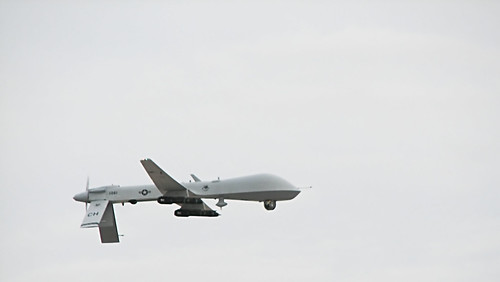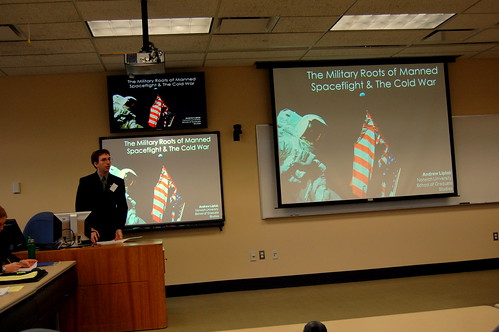In April, I submitted my capstone paper, The Manned Roots of Spaceflight, to the New England Historical Association for their spring conference. After graduating from Norwich's Masters of Military History program, I've found that there are a number of outlets for what I've learned over the 18 months: the internet, personal writing and historical conferences. Last fall, I spoke at the Northeast Popular Culture Association's conference at the Queensboro Community College, presenting a paper that I had written a couple of years ago, prior to starting with Norwich.
There are thousands of national, regional and local historical organizations around the United States and the rest of the world. Major conferences, such as the Society for Military History and the American Historical Association are major events, taking up multiple days, and bringing together hundreds, if not thousands, of historians and intellectuals, and there is a wealth of information presented at each one. However, what I've found is that you don't need to set your sights on the big, major outings to continue doing work in the history field, applying what you now know. Both the Northeast Popular Culture Association and the New England Historical Association held conferences that were interesting, and presented a good opportunity for me to present what I learned.
What I've also learned, is that putting together a Capstone paper and putting together a conference presentation are two different animals altogether.
Where your capstone is a detailed, immaculately researched document, a presentation has to keep to a strict time limit, usually around 20 minutes. In those twenty minutes, you need to find a way to take your major argument and supporting evidence, and present it in a clear and concise method that allows your audience to understand and learn from your argument and findings. Your successes at a conference will predicate on a succinct manner, but also a good presentation style.
At the conference that I presented at recently, I arrived early, and went to an earlier panel, Perspectives on the World Wars, with three panelists. Each presentation had their own merits, with interesting content, but only one was really something that stands out for the argument, explanation and findings. The first panelist had been introduced as having received her Bachelor’s in Performance, and I could tell with her presentation. It was very literary, extremely well spoken, but was largely a reading from a script, with few visuals and no apparent thesis that tied the findings to a larger point. The third presentation offered some similar results from a PhD: there was an interesting premise and thesis laid out, but the execution and presentation of the paper was lacking: the presenter was not concise, examined three separate points that did not really relate more than tangentially together. The third paper, by a district attorney and history student, was spot on. His paper, which looked at the background demographics as put forth by a census, compared the results to the soldiers who died from the town during the 1st World War, in an effort to see if there was a discrepancy between the two. His paper was clear, interesting, to the point, with visuals and plenty of evidence to back up his theory, that the town had not, in fact, sent off its poorer citizens to fight for the more wealthy, and made it clear that his study could be applied to larger pictures as well, with more study. His was an excellent example of what a presenter at an academic conference should be doing when in front of a group.
An article in the New York Times was published recently, called 'We Have Met The Enemy, and He Is PowerPoint'. In it, it looked to a growing number of military officers who use it in Iraq and Afghanistan for major briefings, and that a number of officers were banning the use of the program in their meetings. A recent example, the infamous 'Afghanistan Stability / COIN Dynamics - Development Slide', was so complex that it was remarked that if the slide could be understood, the war was over. As Brig. General H.R. McMaster noted: "It's dangerous because it can create the illusion of understanding and the illusion of control. Some problems in the world are not bullet-izable". That might be true on the battlefield, but I think that the issue is much deeper than creating vague bullet points. Like taking a picture, the quality of the picture doesn't necessarily depend on a really expensive camera, it comes from the person behind the view finder, taking the picture. The same is true with your presentation. Like your capstone, you need to be to the point, listing major topics, and backing them up with as few words as possible. In preparing for my own presentation in April, I ended up re-writing my presentation twice. The first time, I wrote far too much. The second time, I still had too much. My end result was stark: twenty slides, each with a title. Each slide contained a couple of major points, but in sequence, each slide built upon the last, carrying the argument forward each step towards the conclusion. I can't speak to the quality of my own presentation, but I was able to hold to the time limit with a little prompting, but from my standpoint, I covered all of the material, and prompted several questions from the audience about various points of my topic. Like the AS/CD-D slide, too much information on a slide is meaningless to the audience in the room - all that needs to be shown is major points as prompts to highlight your source and keep you on track.
More than ever, your presentation should largely follow what your capstone paper does, or will do. It takes a single thesis, and from that thesis, you support your evidence with concrete facts and sources (although citations aren't usually necessary during the presentation, unless you directly quote something, but be prepared to back up your evidence if asked) before concluding your remarks. Having a set of slides, while I find it helpful, isn't required. I found that my capstone paper worked well for the conference that I was at, and was paired with two other presenters who had papers that related to the Cold War, but that I was the only one who had used a power point presentation. Without power point slides, my fellow presenters had gone through the same thing that I had, looking at some major points in their papers, just without the visual prompts.
To highlight major points and add extra content to my presentation, I added in pictures - something that really doesn't have a place in a capstone paper, to help highlight major points in my paper. The photographs - A picture of Nazi scientists acquired during Operation Paperclip, A B-29, The detonation of the first Soviet nuclear bomb (Joe 1), a V-2 missile test, Sputnik, Werner Von Braun, the NASA Logo, a Gemini-Capture satellite, Astronaut on the Lunar surface, and a final image of an astronaut footprint on the lunar surface, helped to underscore the points during my talk and underscore what my points really needed during a presentation: a way for the audience to connect to my subject matter. Plus, it looked cool - I was able to work images into the backgrounds of the slides, behind the text, where they lurked in the background. At about a minute per slide, I came in with just enough time.
Putting together the presentations for both the New England Historical Association and the Northeast Popular Culture Association taught me several things: that where ever you are, you can likely find a local, regional or national conference in which you can submit your paper for, that putting together a presentation means a big step in presentation away from your capstone, presenting is one of the best things you can do to keep up to date with the field, to learn something new and to network and talk to other people who share interests. Plus, it's a highly enjoyable opportunity, even if you are not presenting. But, make sure that you work to make your presentation just as enjoyable, interesting and informative.


















